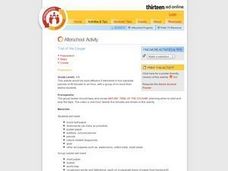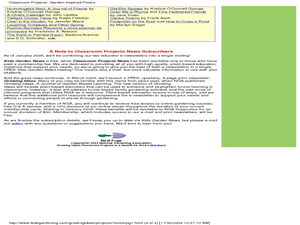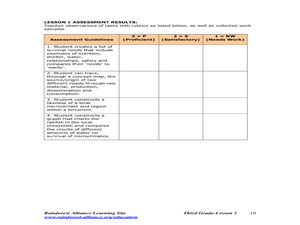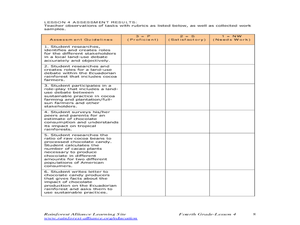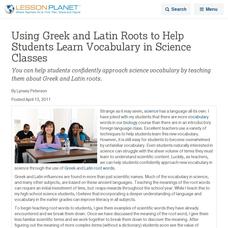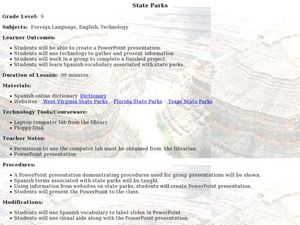Curated OER
Trail of the Cougar
Learners examine cougar behavior, habitat, social organization, efforts to support their survival and the threats to it. They create posters to present information about cougars.
Curated OER
The Red Studio Turns 100!
Students observe the art of Henri Matisse and discuss the ideas and feelings his art brings about. In this Henri Matisse lesson plan, students look at many of his artistic paintings and discuss and write in a journal the point of view...
Curated OER
The Red Studio Shows the Way
Learners look at the painting The Red Studio Shows the Way, and critique the art piece. In this critiquing art lesson plan, students discuss how the painting expresses ideas and feelings and history.
Curated OER
Language Arts: Scavenger Word Hunt
Participate in a scavenger hunt to find objects beginning with a particular letter sound and take digital photos of them with your scholars. Using software, they find word pictures beginning with particular letters and locate picture...
Curated OER
The Presidential Quotation Report
Famous quotations by American Presidents are the focus of this Six Trait writing activity, which could be used in a U.S. History class or in language arts. After reading the picture book Theodore by Frank Keating, have your 7th graders...
Curated OER
Growing Poems
Students write garden inspired poetry. In this poetry lesson plan, students go out into the garden and write poems about how they feel, what they see, and what is going on in the garden.
Curated OER
"Journalism in Tennessee"
High schoolers listen to headline from National Enquirer or other tabloid, listen to story "Journalism in Tennessee," compare and contrast connections between Twain's idea of journalism with present day journalism, define vocabulary, and...
Curated OER
Adjective Games and Associated Worksheets
In this adjective games worksheet, students use adjective wheels, practice spelling adjectives, combine roots words to create an adjective, and explain how different objects using adjectives. Teachers are given detailed information on...
Curated OER
Third Grade Ecuadorian Rainforest
Third graders explore the Ecuadorian Rainforest. In this writing and research lesson students utilize several information sources to learn about the Ecuadorian Rainforest. Students also summarize and paraphrase information learned...
Curated OER
How can we keep our forests intact and have chocolate too?
Fourth graders recognize the need to sustain crops in the rainforest. In this rainforest lesson, 4th graders consider the use of products from the rainforest. Students discuss how people of different points of view decide what to do...
Curated OER
Wolf Fact Cards
Students write a non-chronological report about wolves. They read and discuss wolf fact cards in small groups, complete a KWL chart, observe the teacher model the steps of writing a report, and conduct research and write an original...
Curated OER
Using Greek and Latin Roots to Help Students Learn Vocabulary in Science Classes
You can help students confidently approach science vocabulary by teaching them about Greek and Latin roots.
Curated OER
Christmas Candy
Here is a tasty topic for a lesson: Christmas candy! Third and fourth graders research classic Christmas candies, then create their very own! They write a descriptive paragraph about their candy, then use KidPix to create an illustration...
Curated OER
The Daily Idiom
What is an idiom? Learners identify and read common idioms. They discuss what idioms are, and are given a black line master embedded in the plan that has 100 common idioms. Next, they complete "The Daily Idiom" worksheet, which is...
Curated OER
ADULT ESOL LESSON PLAN--Communicate Effectively on Health and Nutrition Topics
Students, after encountering an intense vocabulary list of health and nutritional terms, examine basic health care requests and issues that might come up in every day situations.
Curated OER
How Can We Keep Our Forests Intact and Have Our Chocolate Too?
Fourth graders explore various methods of growing and harvesting rainforest foods in order to sustain its biodiversity. They discuss the various uses for trees from several viewpoints. Students research chocolate demand and land use...
Curated OER
Ecuadorian Rainforest: If the Forests Could Talk
Third graders explore the delicate balance the must be maintained in a rainforest ecosystem. In this ecosystems activity, 3rd graders learn about the importance of "little things" such as bugs or a certain plant in the rainforest. This...
Curated OER
Let's Go to the Farm
Students explore corresponding letters of the alphabet with the corresponding phonemes using farm animals. They create a classroom word wall of the items they saw on a trip to the farm or zoo. Students create pictures to go along with...
Curated OER
ADULT ESOL LESSON PLAN--Concepts of Time and Money
Students identify different denominations of United States currency and symbols associated with money and reading prices. In addition, in pairs they identify examples of currency from newspapers and magazines.
Curated OER
Write a Space Poem
Pupils write a variety of space travel poems that will be used to compile a class book and draw their own rocket and half fill it with words associated with space travel and add design and color.
Curated OER
Old and New Compound Nouns
In this compound nouns worksheet, students cut out cards with compound nouns on them and put them into a Venn diagram. Students have 36 cards to put into the Venn diagram.
Curated OER
State Parks: A Spanish Vocabulary Lesson
Ninth graders create a PowerPoint about state parks using Spanish vocabulary. In this Spanish lesson, 9th graders work in groups to research about area recreational facilities. Students use information collected on-line to create and...
Curated OER
Fighting Fire With Satire
Students consider satire in the news by exploring various sources of "fake news," and then creating their own political satire in the form of a skit, news article, or cartoon.
Curated OER
Mammal Morphology - Bats, People, and Other
In this physical characteristics worksheet, students compare bats and humans by putting a + sign in the chart for whether or not bats and humans have the same characteristics. Students do this for 17 characteristics and answer 3 questions.


